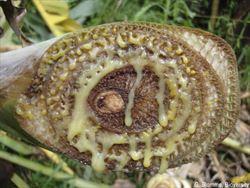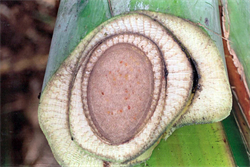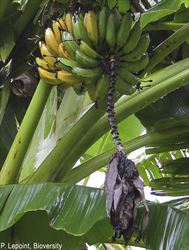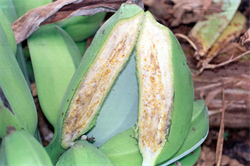- Narrow. Initially in Ethiopia. Now throughout East and Central Africa.
- Major bacterial disease of banana and enset, and their wild varieties. ABB are especially susceptible. Massive losses in Uganda beginning in 2001.
- Two routes of infection:
- (i) Suckers already infected at planting or later from contaminated knives when pruning or harvesting: leaves turn yellow, collapse and hang down around the stem; internally, vascular tissues are cream/yellow/pink, and spaces within leaf sheaths fill with ooze.
- (ii) Insects carring bacteria to male flowers and their covering leaves. Male buds (‘bell’) blacken and rot, fruits develop internal reddish rots; fruit (‘fingers’) yellow prematurely (although often the whole bunch remains green), and vascular tissues of flower stalk turn yellow-orange. Bacteria then travel to rest of plant, followed by yellowing, wilting, death, and sucker infection.
- Spread: infected suckers, knives, insects, fruits. Infection from soil is uncertain as survival is short. Biosecurity: risk from unofficial introduction of diseased cuttings for propagation, and trade in fruit. Official movement of germplasm should always follow the FAO/IPBGR Technical Guidelines.
- Biocontrol: none.
- Cultural control: most important recommendations for smallholders are: (i) monitoring and removal of disease plants as soon as seen, but NOT necessarily the entire mat - not all suckers become systemically infected; (ii) removal of unopened male flower buds (called 'de-budding') using forked stick; and (iii) keeping cutting tools clean and free from bacteria (bleach). Others: disease-free suckers; do not plant near diseased plots (especially downwind); limit access to visitors/workers/animals; bag flowers after emergence until fruit set (if bell removed); check availability resistant varieties from Bioversity International and IITA.
- Chemical control: not a method to use.
Pacific Pests, Pathogens and Weeds - Online edition
Pacific Pests, Pathogens, Weeds & Pesticides
Banana xanthomonas wilt (523)
Banana xanthomonas wilt. It is also known as Xanthomonas wilt, banana bacterial wilt or enset wilt (enset, or false banana, is in the same family as banana, but used, almost exclusively in Ethiopia, for the starch of its rhizome and stem).
Xanthomonas vasicola pv. musacearum; it was previously known as Xanthomonas campestris pv. musacearum. The abbreviation is BXW.
AUTHOR Grahame Jackson
Information from Blomme G, et al. (2017) Bacterial diseases of banana and enset: Current state of knowledge and integrated approaches toward sustainable management. Frontiers in Plant Science. (https://www.frontiersin.org/articles/10.3389/fpls.2017.01290/full#B66); and Drenth A, Kema G (2021) The vulnerability of bananas to globally energing disease threrats. Phytopathology 111: 2146-2161; and CABI (2021) Xanthomonas campestris pv. musearum (banana xanthomonas wilt (BXW)). Crop Protection Compendium. (https://www.cabi.org/cpc/datasheet/56917); and Vezina A (2020) Xanthomonas vesicola pv. musacearum (2020). Musapedia, the banana knowledge compendium. Promusa. Date of last modification: 22 September. (https://www.promusa.org/Xanthomonas+vasicola+pv.+musacearum); and from (and Photos 1&2) Xanthomonas wilt of banana. ProMusa. (https://www.promusa.org/Xanthomonas+wilt). Photo 1 Guy Blomme, Bioversity International. (https://www.musarama.org/photo-522-BXW_pseudostem_symptoms). Photos 2&3 Pascal Lepoint, Bioversity International. (https://www.musarama.org/photo-517-BXW_fruits_symptom). Photo 4 Banana sucker infected with Banana Xanthomonas Wilt in Uganda. (https://www.flickr.com/photos/iita-media-library/6755030657/in/photostream/). Photo 5 Banana fruits infected with Banana Xanthomonas Wilt in Uganda. (https://www.flickr.com/photos/iita-media-library/6755031667/in/photostream/).
Produced with support from the Australian Centre for International Agricultural Research under project HORT/2016/185: Responding to emerging pest and disease threats to horticulture in the Pacific islands, implemented by the University of Queensland, in association with the Pacific Community.
*The codes ABB and BBB are the amount of Musa acuninata and Musa bulbisiana (parents of many banana varieties grown) represented in each banana variety. An internationally recognised scoring system is used to determine the proportion.








